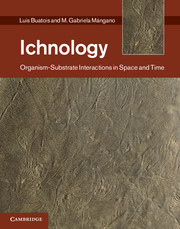Book contents
- Frontmatter
- Contents
- Acknowledgments
- Introduction
- Part I Conceptual tools and methods
- Part II Spatial trends
- Part III A matter of time
- 12 Trace fossils in sequence stratigraphy
- 13 Trace fossils in biostratigraphy
- 14 Trace fossils in evolutionary paleoecology
- 15 Ichnology in paleoanthropology and archaeology
- References
- Index
14 - Trace fossils in evolutionary paleoecology
from Part III - A matter of time
Published online by Cambridge University Press: 25 October 2011
- Frontmatter
- Contents
- Acknowledgments
- Introduction
- Part I Conceptual tools and methods
- Part II Spatial trends
- Part III A matter of time
- 12 Trace fossils in sequence stratigraphy
- 13 Trace fossils in biostratigraphy
- 14 Trace fossils in evolutionary paleoecology
- 15 Ichnology in paleoanthropology and archaeology
- References
- Index
Summary
There is nothing like the Cambrian until the Cambrian.
Andrew Knoll Life on a Young Planet: The First Three Billion Years of Evolution on Earth (2004)Some of these ideas were already touched upon by Darwin, such as the notion that burrowing organisms have a proportionally large impact on their environment, which is now formalized in the concept of ecosystem engineering. Other ideas were unforeseen, such as the role that bioturbation had during the Cambrian explosion. This establishes a strong link between Darwin’s bioturbation book and On the Origin of Species, a connection that would have certainly astounded the author.
Filip Meysman, Jack Middelburg, and Carlo Heip “Bioturbation: a fresh look at Darwin’s last idea” (2006)Timing is the complex part of simplicity.
Keith Jarrett The Art of Improvisation (2005)Because ichnological analysis commonly emphasizes the long temporal range of most ichnotaxa (see Section 1.2.8), trace fossils have been traditionally overlooked as a source of information in macroevolution. However, comparisons of ichnofaunas through geological time do reveal the changing ecology of organism–substrate interactions. The use of trace fossils in evolutionary paleoecology represents a relatively new trend in ichnology that is providing important information for our understanding of patterns and processes in the history of life. In particular, Bambach (1983) understood the history of life as a process of colonization that implies the exploitation of empty or underutilized ecospace (see also Bambach et al., 2007). Trace fossils may provide crucial evidence for the recognition of spatial and temporal patterns and processes associated with paleoecological breakthroughs (e.g. Seilacher, 1956, 1974, 1977b; Crimes, 1994, 2001; Buatois and Mángano, 1993b; Buatois et al., 1998c, 2005; Orr, 2001; Mángano and Droser, 2004; Uchman, 2004a; Carmona et al., 2004; Jensen et al., 2005; Seilacher et al., 2005; Mángano and Buatois, 2007).
- Type
- Chapter
- Information
- IchnologyOrganism-Substrate Interactions in Space and Time, pp. 265 - 291Publisher: Cambridge University PressPrint publication year: 2011

